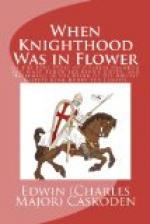It is true that in the time of Edward IV a Caskoden did stoop to trade, but it was trade of the most dignified, honorable sort; he was a goldsmith, and his guild, as you know, were the bankers and international clearance house for people, king and nobles. Besides, it is stated on good authority that there was a great scandal wherein the goldsmith’s wife was mixed up in an intrigue with the noble King Edward; so we learn that even in trade the Caskodens were of honorable position and basked in the smile of their prince. As for myself, I am not one of those who object so much to trade; and I think it contemptible in a man to screw his nose all out of place sneering at it, while enjoying every luxury of life from its profits.
This goldsmith was shrewd enough to turn what some persons might call his ill fortune, in one way, into gain in another. He was one of those happily constituted, thrifty philosophers who hold that even misfortune should not be wasted, and that no evil is so great but the alchemy of common sense can transmute some part of it into good. So he coined the smiles which the king shed upon his wife—he being powerless to prevent, for Edward smiled where he listed, and listed nearly everywhere—into nobles, crowns and pounds sterling, and left a glorious fortune to his son and to his son’s son, unto about the fourth generation, which was a ripe old age for a fortune, I think. How few of them live beyond the second, and fewer still beyond the third! It was during the third generation of this fortune that the events of the following history occurred.
Now, it has been the custom of the Caskodens for centuries to keep a record of events, as they have happened, both private and public. Some are in the form of diaries and journals like those of Pepys and Evelyn; others in letters like the Pastons’; others again in verse and song like Chaucer’s and the Water Poet’s; and still others in the more pretentious form of memoir and chronicle. These records we always have kept jealously within our family, thinking it vulgar, like the Pastons, to submit our private affairs to public gaze.
There can, however, be no reason why those parts treating solely of outside matters should be so carefully guarded, and I have determined to choose for publication such portions as do not divulge family secrets nor skeletons, and which really redound to family honor.
For this occasion I have selected from the memoir of my worthy ancestor and namesake, Sir Edwin Caskoden—grandson of the goldsmith, and Master of the Dance to Henry VIII—the story of Charles Brandon and Mary Tudor, sister to the king.




